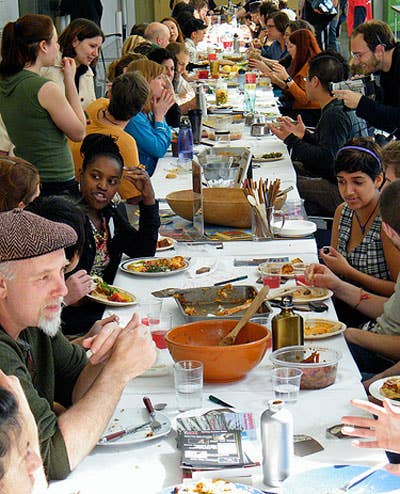
Events: Support For School Lunch Programs
Remember the bored-looking lunch lady, sporting her signature hairnet, shoveling some mystery meat and gloppy green goo onto your awaiting tray? For many of us, memories of the school cafeteria are not exactly pleasant. In fact, too many schools still serve a lunch composed of mass-produced foods and lacking fresh fruits or vegetables. That's why Slow Food USA is sponsoring "Eat-Ins" across the country this Labor Day to draw attention to the coming renewal of the Child Nutrition Act.
Despite its negative associations, the public school lunch program is rooted in a spirit of benevolence. In his history of the subject, former USDA administrator Gordon W. Gunderson explains that the feeding of students at school was intended to increase learning potential through proper nourishment. In the mid-1880s, the first school lunches were funded by private philanthropic societies responding to the needs of poverty-stricken children. During the Great Depression, New Deal legislation provided financial assistance to public schools for feeding their students but also to farmers who supplied food for school lunches. In 1946, the National School Lunch Act further solidified the role of Congress in the feeding of children across the country, stating that "the health and well-being of the Nation's children" depended on it.
The school lunch program continued to expand, and in 1966, with the enactment of the Child Nutrition Act, the focus shifted to nutritious food that met specific guidelines. The act remains in effect today, as does its stated aim of providing nutritious meals to the more than 30 million students it now serves; now that almost one-fifth of America's children are struggling with obesity, however, many believe that the legislation is simply not doing its job. Critics cite a continued absence of fresh fruits and vegetables and question the presence of vending machines and fast-food vendors on many school campuses.
As the time for the renewal of the act approaches, later this month, Slow Food USA is working to reveal the flaws in the current legislation. To the organization's Time for Lunch "Eat-Ins" in every state across the country on Labor Day, participants are asked to bring a dish to share with other attendees, turning the event into what Slow Food USA president Josh Viertel describes as "a picnic, a potluck, and a virtual march on Washington." Although there are no rules as to what people should contribute to the organizers' anticipated total of 300 Eat-Ins, they are encouraged to "bring food they believe in," says Slow Food USA representative Brian Sinderson. "For some that might be something they want their kid to be served in the school cafeteria."
The contents of an ideal school lunch will vary from state to state, in keeping with the focus on local ingredients that is key to the campaign's aims. The organizers hope that an increase in funding for the Child Nutrition Act will allow school districts to establish connections with nearby farmers and will fund grants for farm-to-school programs that utilize farm and garden classrooms to teach students about good nutrition and sustainable agriculture.
Additional funding will also translate into a $1.00 increase per student, boosting the amount spent on each child per lunch to $3.68. In an e-mail, Viertel highlighted the significance of such an increase: "With one more dollar per lunch per day, schools could buy more fresh fruits and vegetables and could start buying some ingredients locally."
With hundreds of Eat-Ins planned and a corresponding petition to Congress containing 15,000 signatures and counting, Slow Food USA is optimistic that this marks the start of a long-lasting movement. Perhaps that means that the lunch lady of our collective memory, surrounded by a bounty of fresh produce, won't be so bored as she serves the next generation a healthful, satisfying lunch. —Katie Robbins, SAVEUR
Keep Reading
Continue to Next Story










